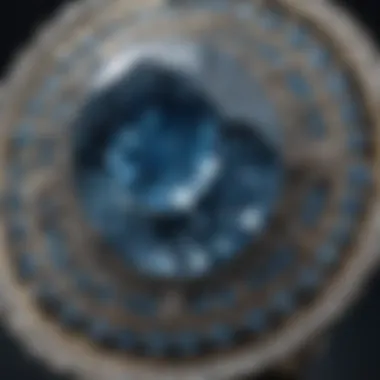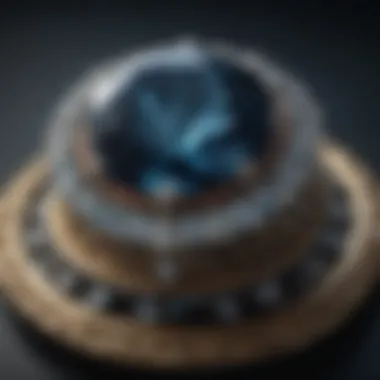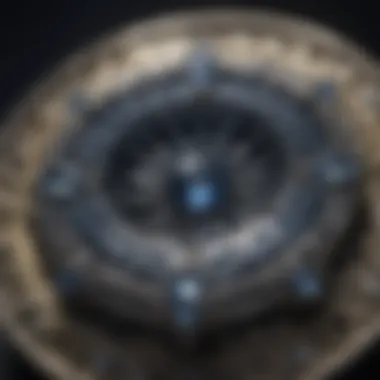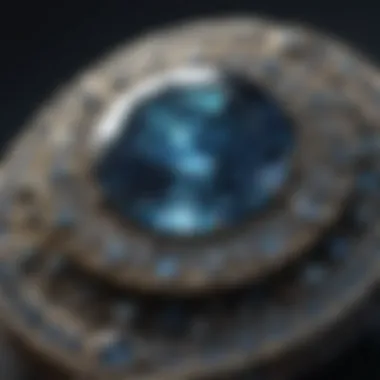The Enduring Value of the Hope Diamond


Intro
The Hope Diamond stands as a significant symbol in the realm of gemstones. This unique diamond boasts a rich tapestry of history, intriguing myths, and an unmatched aesthetic appeal. Its worth is not merely defined by its monetary value; rather, it encompasses a broader narrative that weaves together historical events, cultural significance, and market dynamics. Understanding this gemstone requires a holistic approach, considering various aspects that contribute to its standing in the esteemed circle of precious gems.
Gemstone Overview
Definition of Gemstones
Gemstones are naturally occurring minerals, rocks, or organic materials valued for their beauty, durability, and rarity. They are typically cut and polished to enhance their visual appeal, making them desirable for use in jewelry and other decorative items. The Hope Diamond is classified as a colored diamond due to its striking blue hue, which is a result of the presence of boron in its composition.
Classification of Gemstones
Gemstones can be broadly classified into two categories: precious and semi-precious stones. Precious stones include diamonds, rubies, sapphires, and emeralds, known for their quality and rarity. Semi-precious stones encompass a wider range, including amethysts and garnets. The Hope Diamond, undeniably, belongs to the precious stones category, given its exceptional color, historic value, and market demand.
Historical Significance
Origins of Gemstone Use
The use of gemstones extends back thousands of years, with early civilizations adopting them for various purposes. Gemstones have been believed to possess mystical properties or serve as status symbols. The Hope Diamond's journey likely began in India, where it was mined and revered by royalty. Its subsequent travels through Europe and America illustrate the shifting tides of ownership and the evolving perceptions of value.
Cultural Insights: Gemstones in Ancient Civilizations
Ancient cultures often linked gemstones with power, spirituality, and protection. For example, in Egypt, turquoise and lapis lazuli were thought to provide protection in the afterlife. The Hope Diamond has a storied place in such traditions, believed by some to bring misfortune to its owners. This lore adds another layer to its allure, enhancing both its cultural significance and financial worth.
"The Hope Diamond's value transcends monetary worth; it is a relic of human history and culture."
The examination of these various facets provides insight into how gemstones like the Hope Diamond shaped and were shaped by historical contexts. As we delve deeper into its unique attributes and the forces that impact its valuation, a more comprehensive understanding of its place in the gemstone world emerges.
Intro to the Hope Diamond
The Hope Diamond is a captivating subject, rich in history and intrigue. This introduction provides essential context for understanding its enormous significance in the gemstone market. The diamond not only boasts an intriguing backstory but is also a prominent symbol of wealth and beauty. Examining the Hope Diamond serves to illuminate broader themes within the field of gemology, including the interplay between rarity and value, as well as cultural interpretation. Thus, this sections sets a strong foundation for exploring its characteristics and the factors that affect its valuation.
Historical Background
The Hope Diamond’s storied past is essential to its allure. Originally discovered in India, it has passed through various hands and cultures. The diamond was initially part of a larger stone, the Tavernier Blue, which was acquired by the French gem merchant Jean-Baptiste Tavernier in the 17th century. Tavernier sold it to King Louis XIV, marking the stone's initial entry into royal circles. Over the centuries, the diamond changed ownership multiple times, leading to a mythology surrounding bad luck and curses associated with its possession. This history is critical for understanding why the Hope Diamond is valued not just for its physical qualities but also for its narrative.
Physical Characteristics
Color
The color of the Hope Diamond is one of its most distinguishing features. It possesses a rare blue hue attributed to the presence of boron in its molecular structure. This intense blue is a key characteristic that enhances its desirability among collectors and gemologists alike. The diamond's brilliance is further amplified by its unique shade, making it a sought-after gem in various markets. Overall, the striking color contributes immensely to the diamond’s reputation and value.
Weight
Weighing approximately 45.52 carats, the Hope Diamond's weight establishes it as one of the largest of its kind. Heft is often a crucial factor in gemstone valuation, with larger stones typically commanding higher prices. The diamond's considerable weight also adds to its presence when displayed, creating a considerable impact that captures attention. Given its size, the Hope Diamond remains a standout piece in any collection.
Clarity


The clarity of the Hope Diamond references the internal characteristics, or inclusions, within the gemstone. It is graded as having "very good" clarity, with only minimal inclusions visible under magnification. This characteristic is critical because higher clarity typically leads to greater value. In the case of the Hope Diamond, its clarity enhances its brilliance, making it more visually appealing than many other gemstones. Clarity thus plays an important role in its overall worth.
Cut
The diamond is cut in a cushion shape, designed to maximize its brilliance and fire. The quality of a diamond cut can greatly influence its value. The cushion cut effectively showcases the Hope Diamond's unique color and character. This specific cut is quite popular, reflecting the enduring appeal of vintage aesthetics in modern jewelry. Therefore, the cut is a significant factor in establishing the diamond's market position.
The Diamond's Journey
Origin
The Hope Diamond originated from the Golconda mines in India, renowned for producing some of the world's most famous gemstones. This origin is significant as it links the diamond to a historical context that enhances its appeal. Golconda stones are highly prized, making the diamond's roots a critical component of its value in the gemstone market.
Ownership Timeline
From its initial acquisition by Tavernier to its current place in the Smithsonian Institution, the ownership journey of the Hope Diamond reflects both historical fluctuations and modern consumption. This timeline illustrates the diamond's continuous allure across generations and cultures. Each owner added layers to its story, elevating its status every time it changed hands.
Notable Owners
The diamond has had many notable owners, including Louis XIV, the infamous Marie Antoinette, and the American socialite Evalyn Walsh McLean. Each of these individuals contributed to the diamond’s legend, affecting its cultural significance. Notable owners amplified the diamond's cachet, resulting in a narrative that enhances its monetary value.
The Hope Diamond’s history of ownership tells a story beyond its physical attributes, weaving a tapestry of intrigue and fascination that has captivated admirers for centuries.
In summary, the various characteristics of the Hope Diamond, along with its rich historical background, strongly contribute to its worth in both monetary and cultural terms. Each aspect, like color and weight, intersects with the diamond's journey, enriching its narrative and market presence.
Factors Influencing the Value of the Hope Diamond
Understanding the value of the Hope Diamond requires a multifaceted approach. Its worth is not merely a function of its physical attributes but is influenced by rarity, market valuation, and cultural significance. Each factor plays a crucial role in shaping perceptions and determining the diamond's financial value.
Rarity and Demand
Rarity forms the bedrock of the diamond's worth. The Hope Diamond is a unique gem due to its rich color and historical provenance, making it a highly sought-after piece. The interplay between rarity and demand elevates its status beyond that of ordinary gemstones. Collectors and enthusiasts often pursue rare items, leading to an increased valuation. Furthermore, a limited supply creates competition among potential owners, further driving prices up.
Market Valuation Approaches
Appraisals
Appraisals serve as a primary method for assessing the Hope Diamond's value. Experts provide tailored evaluations based on its unique characteristics. One key trait of appraisals is the ability to evaluate the diamond within its specific historical context. This personalized assessment can help buyers and sellers understand the significance of the diamond in the market. However, appraisals can be subjective, with different experts giving varying values based on their perspectives.
Comparative Sales
Comparative sales involve analyzing similar gemstones' sales data to gauge the Hope Diamond's market value. This method compares recent sales of diamonds with comparable characteristics. A significant characteristic of comparative sales is its reliance on real-world data, providing more objective insights into the diamond's worth. That said, finding directly comparable diamonds can be challenging, and the subjective nature of value can still impact conclusions.
Historical Auctions
Historical auctions represent another essential aspect of market valuation. Auction records of the Hope Diamond and similar gems provide critical data points for understanding its worth. A defining feature of historical auctions is their ability to reflect real market demand in a competitive bidding environment. While auctions can sometimes generate extraordinary sale prices, they may not always represent the diamond's intrinsic value accurately due to emotional factors influencing bidders.
Cultural Significance


The cultural significance of the Hope Diamond adds layers to its value beyond the financial aspect. It embodies powerful symbolism and has been the subject of many folk tales and media representations.
Symbolism
Symbolism surrounding the Hope Diamond enhances its overall allure. Throughout history, the diamond has been intertwined with themes of love, wealth, and mystery. This fascination makes it a popular object of curiosity, driving interest and contributing to its higher valuation. However, varying perceptions of what the diamond signifies to different cultures can complicate its position in the market.
Folk Tales and Legends
Folk tales and legends tied to the Hope Diamond enrich its narrative and subsequent value. These stories often depict the diamond as carrying a curse, nurturing an aura of intrigue. This aspect becomes a double-edged sword. While it attracts attention and can increase desirability, it may also deter some potential buyers who fear potential bad luck.
Media Representations
Media representations further cement the Hope Diamond's status as a cultural icon. Appearances in films and literature contribute to its mystique, attracting a broader audience. However, the portrayal of the diamond can sometimes lead to misconceptions about its true value and significance, showcasing how interpretation can influence public perception.
"The Hope Diamond remains not just a gemstone, but a topic rich with history and meaning."
In summary, the factors influencing the value of the Hope Diamond are intertwined and multifaceted. Rarity, market valuation methods, and cultural significance merge to create a compelling narrative around this gemstone. This narrative adds complexity to its valuation, extending beyond monetary worth to encompass emotional and cultural dimensions.
Controversies Associated with the Diamond
The controversies connected to the Hope Diamond are crucial in understanding its allure and mystique. For gemstone enthusiasts and collectors, these disputes and stories serve not only as captivating tales but also contribute to the diamond's perceived worth and rarity. The narratives that surround the diamond often amplify its status, making it not only a stunning piece of jewelry but also a cultural icon. These aspects could reveal much about human nature, desires, and the sometimes-dark undercurrents of historical artifacts.
Curse of the Hope Diamond
The curse of the Hope Diamond is perhaps its most famous and intriguing aspect. Many owners of the stone have claimed to suffer misfortunes and tragedies. These tales often include accidents, financial ruin, and even untimely deaths. Whether these accounts are steeped in mere superstition or have a basis in fact remains debatable.
This lore enhances the diamond’s allure, attracting collectors not only for its intrinsic beauty but also for its historical narratives. Those who believe in the curse argue that the diamond carries a malevolent spirit or energy, causing harm to its possessors. Skeptics, however, attribute the unfortunate events to coincidence and the pressures that come with wealth and fame.
Regardless of the truth, it is clear that the curse adds a layer of complexity to the diamond’s story. The fear and fascination surrounding the curse contribute to its market value, providing a compelling narrative that captivated many.
Theft and Preservation
Notable Heists
The heists involving the Hope Diamond have had a profound impact on its legacy. One of the most notorious thefts occurred in 1958 when it was removed from the Smithsonian Institution in Washington, D.C. While it was recovered shortly afterward, the incident raised questions regarding security surrounding such a valuable artifact.
These notable heists highlight the diamond's iconic status, reinforcing its desirability in the eyes of both criminals and collectors. The audacity and planning required for these thefts can be viewed as a testament to the diamond's worth.
Moreover, each theft has added to the diamond's narrative, making it more enticing for potential buyers and collectors. The risks associated with owning the diamond enhance its collectability—many collectors are drawn not just to the gem's beauty but also to its thrilling past.
Security Measures
The security measures in place to protect the Hope Diamond are essential for its preservation. With its high value and storied history, ensuring the diamond's safety is paramount. Various measures have been implemented, including state-of-the-art surveillance systems and secure display cases.
These extensive security protocols serve as a reminder of the diamond's importance in both the gem and museum sectors. They also underscore the challenges of safeguarding artifacts that are not only precious but also heavily sought after.
While strict security measures protect the diamond, they can inhibit public access and appreciation. Collectors may find themselves considering the implications of security when dreaming of owning such a storied piece.


The intersect of security and desirability creates a dynamic landscape for the Hope Diamond, influencing its value and place within the gemstone market.
Understanding the controversies associated with the Hope Diamond enriches the overall narrative surrounding it. These dimensions contribute not just to its historical significance but also shape its ongoing market position.
Current Market Position
Understanding the current market position of the Hope Diamond is essential for comprehending its captivating worth. This diamond is not only a stunning gemstone but also a piece of history, art, and culture that influences its valuation. By examining factors like valuation methods and potential future value, it becomes evident how market dynamics shape perceptions and investments in this extraordinary stone.
Valuation Methods
Expert Surveys
Expert surveys are a primary method for gauging the value of the Hope Diamond. These surveys tap into the insights of gemologists and jewelers who possess extensive knowledge about high-value gemstones. One key characteristic of expert surveys is their reliance on professional opinion. This makes them a beneficial choice for determining the current market value of such a unique gem.
Expert surveys provide a unique feature: the collective wisdom of experienced individuals in the field. Their insights can highlight trends and shifts in valuation that may not be apparent through traditional metrics. However, there are some disadvantages in this approach. The subjective nature of expert opinion may lead to varying conclusions among different appraisers.
Investment Appraisals
Investment appraisals offer another perspective on the Hope Diamond’s worth. This method focuses on the financial potential of the diamond as a long-term asset. A key characteristic of investment appraisals is their emphasis on return on investment, which is vital for collectors and investors looking to gauge worth over time. This method is especially beneficial for understanding the Hope Diamond's role as a solid investment choice in the luxury market.
The unique feature of investment appraisals is their detailed analysis of market performance and past sales data, which helps inform future investment decisions. However, investment appraisals can also have drawbacks. They often rely on fluctuating market conditions that may not reflect the diamond's intrinsic value. As a result, predictions may vary significantly.
Potential Future Value
Understanding the potential future value of the Hope Diamond provides valuable insights into its market position. By analyzing market trends and investment outlook, collectors and enthusiasts can better comprehend what lies ahead for this iconic gemstone.
Market Trends
Market trends reveal a wealth of information about the changing dynamics around valuable gemstones. The relationship between the Hope Diamond and broader market trends can help predict how demand may shift over time. One key characteristic here is the responsiveness of the gemstone market to global economic factors, making it a beneficial lens through which to examine the diamond's future.
The unique feature of market trends is their ability to show fluctuations based on various external influences, such as economics or fashion trends. However, this approach also has disadvantages. Market trends can be volatile and may not always provide a clear direction for specific gems like the Hope Diamond.
Investment Outlook
Investment outlook looks specifically toward the potential returns of incorporating the Hope Diamond into a collection or portfolio. This method is essential for understanding long-term value. A key characteristic of this outlook is its forward-looking nature, making it an advantageous choice for collectors who are considering long-term strategies.
The unique feature here lies in its capacity to interpret current data, helping collectors and investors gauge the diamond's position in the luxury market. However, there are disadvantages too, as the investment outlook can shift rapidly based on various economic or cultural trends, making predictions difficult.
> The worth of the Hope Diamond is not solely defined by its price tag; it embodies history, culture, and the allure of rarity that captures the imagination of connoisseurs around the world.
Culmination
The conclusion serves as a crucial element in illuminating the various dimensions of the Hope Diamond's worth. It synthesizes the extensive research conducted throughout the article, outlining key insights into historical significance, market valuation, and cultural relevance. Readers are left with a comprehensive understanding of why this gemstone holds such fascination and value.
Summary of Findings
Throughout this investigation, several key points emerged regarding the Hope Diamond:
- Historical Significance: The diamond's storied history, from its origin in India to its current display at the Smithsonian Institution, emphasizes its global impact. Its journey through various ownerships tells a tale of royalty, wealth, and intrigue.
- Physical Characteristics: The diamond's unique attributes, such as its deep blue color, clarity, and substantial weight, differentiate it from other gemstones. These characteristics greatly influence its desirability and price.
- Market Dynamics: Current market trends and historical valuation approaches illustrate fluctuating interest among collectors and investors. Understanding these dynamics provides insight into the diamond's present and future financial viability.
- Cultural Impact: The lore surrounding the Hope Diamond, including its alleged curse and appearances in media, enhances its mystique. This cultural significance contributes to its enduring appeal.
Final Thoughts
"The Hope Diamond is not just about wealth; it encompasses a rich tapestry of narratives that enrich our understanding of gemstones and their significance in our world."
This exploration of the Hope Diamond has unraveled its complexities, fostering appreciation among those who value not just the stone itself, but the history and meaning behind it.



